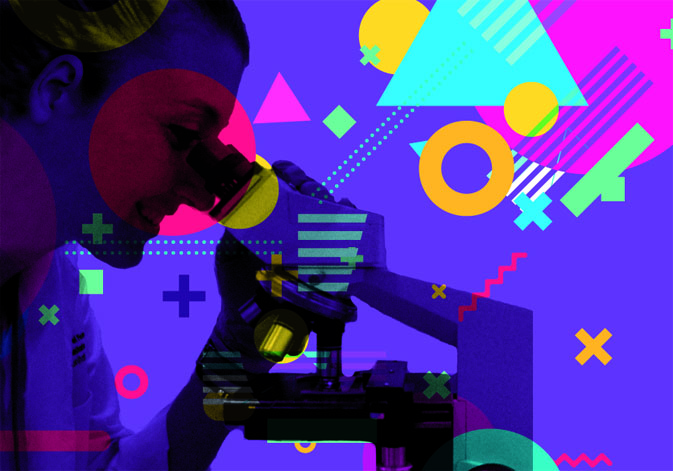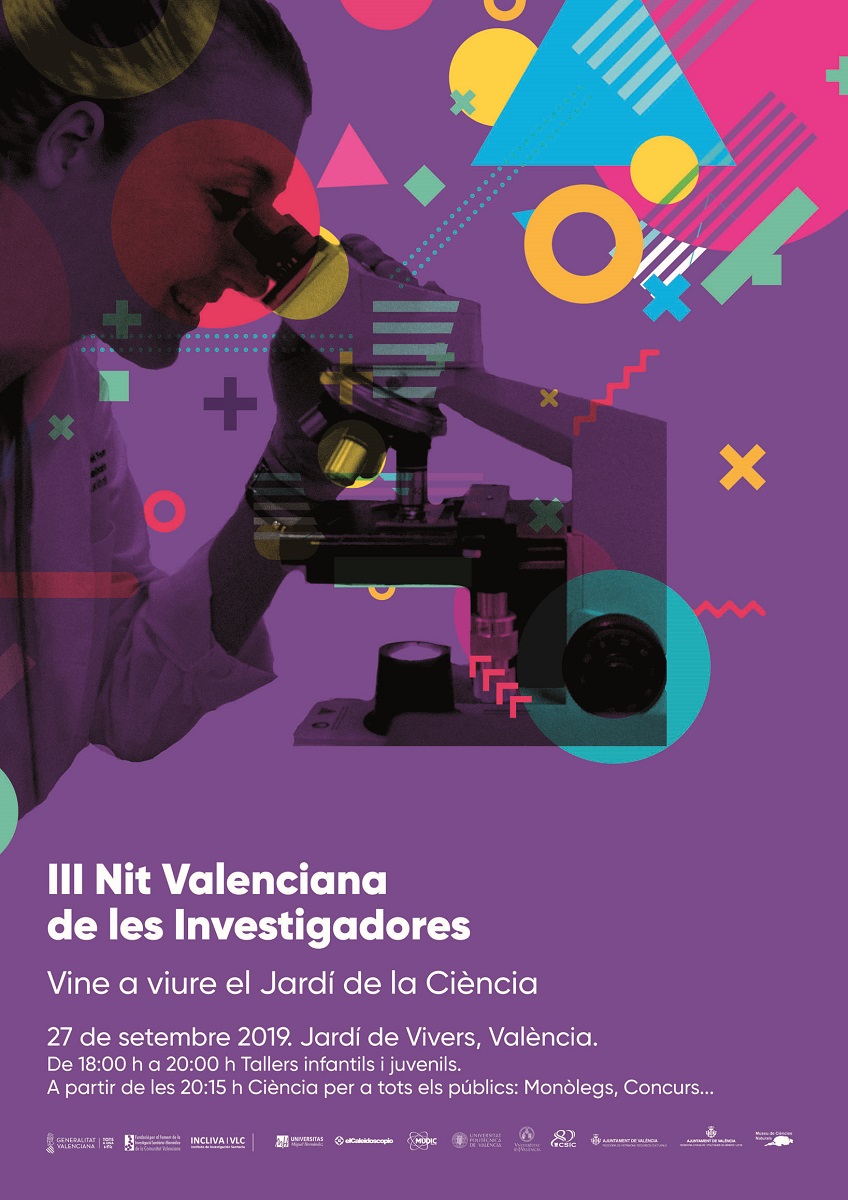
Viveros Garden became last Friday, September 27 the garden of science. This emblematic green space of Valencia was the place chosen to host the third edition of the Nit Valenciana de les Investigadores, dedicated to female researchers. Under the motto “Vine a viure el jardí de la ciència (‘Come to live the garden of science’), there were activities and shows for all tastes and ages: scientific workshops for girls, boys and young people, talks about Valencian research, relaxed monologues, free visits to the Museum of Natural Sciences of Valencia and the Church of San Nicolás of Valencia, among other activities.
“The University of Valencia is committed to equality, and that is why we support the fact that female scientists and researchers are known, visible and can show their abilities”, said the Vice Chancellor for Innovation and Transfer, María Dolores Real. In addition, she added: “we joined the European Researchers Night through the III Nit Valenciana de les Investigadores to show this commitment and help make it happen”.
The III Nit Valenciana de les Investigadores was organised by the University of Valencia (UV), the Foundation for the Promotion of Biomedical and Health Research of the Valencian Community (FISABIO), the Polytechnic University of Valencia (UPV), the Higher Council of Scientific Investigations (CSIC), the INCLIVA Institute of Health Research, the Museum of Natural Sciences of Valencia, the Department of Heritage and Natural Resources and Gender Equality and Policies and LGBT of the City Council of Valencia and El Caleidoscopio, company of the scientific park of the Miguel Hernández University of Elche (UMH).
The activities in Viveros began at 6 pm with a series of workshops aimed at flourishing new scientific vocations and bringing science closer to Valencian society. To give several examples, there was an XXL board to learn about bacteria while playing, two workshops to understand from the genetic perspective why we are all the same as well as different, to make slime, build a bridge with spaghetti or identify microplastics in common salt and water.
Simultaneously to the workshops, those who participated could approach the photocall of the event and immortalised in video format their experience and their opinion about the importance of science.
Relaxed talks and monologues about science
The children’s and youth workshops, and visits to the Museum of Natural Sciences concluded around 20 hours and then began a series of monologues and relaxed conversations between scientists.
Dr. Vicente Navarro and Anna Quirant (FISABIO) talked about how to properly feed our bacteria and explained the latest research on their relationship with diseases such as Alzheimer’s or atopic skin.
For his part, Dr. Carlos Roma (INCLIVA Health Research Institute) explained what they are, what they are for and why it is important to donate tissues and organs to biobanks.
Dr. Ana Lluch (UV) stated about the latest in La investigación en cáncer de mama (‘Breast Cancer Research’) and Dr. Dolors Corella (UV) discovered El sabor de las ómicas en nutrición y salud (‘The taste of omics in health and nutrition’).
Mª Pilar López Gresa and Purificación Lisón, scientists of the Institute of Molecular and Cellular Biology of Plants (UPV-CSIC) made people smile with the monologue El aroma de la Resistencia, which detailed how tomatoes emit a scent that can protect our crops against drought.
Finally, Berta Rubio (IFIC) talked about the origin of chemical elements and Nuclear Physics and Emilia Matallana (I2SysBio) of why Producir vino es un arte (‘Producing wine is an art’).
The climax was the performance of the IES musical group Berenguer Dalmau (Catarroja), one of the winners in the 2019 video contest to promote scientific vocations “De major vull ser com…” (‘When I grow old I want to be like…’).
The journalist specialised in cultural and scientific information Reis Juan conducted the evening, in which the audience could also test their knowledge of science through an interactive game.
The event was celebrated on the occasion of the European Researchers Night, a project of the European Commission to bring the most human part of the Research to citizens and which took place in 300 cities across the continent.
The activities were open to the public and no prior registration was needed. All citizens were invited to attend and enjoy this European day that turned Los Viveros into a garden sown with science to grow new scientific vocations and make visible the importance of research and innovation.
ACTIVITIES ANNEX
FISABIO Foundation
Bacteriopolis game
As if it were the goose game, the participants will become bacteria that will advance along a giant board until they reach the Fisabio laboratories. In the special boxes we will learn, for example, that Lactobacillus turn milk into yogurt or that some bacteria may be resistant to antibiotics.
Biomedical scavenger hunt
Scientific test with five questions that participants can solve by following the clues. Finding out all the answers will be rewarded!
Workshop-recipe Your DNA in a tube
With the help of Fisabio scientists, we will learn to extract the DNA from cells in our mouth and we can see how it floats in the test tube!
Microscopic life workshop
What is a microorganism? How is a bacterium grown? Have you never observed a hair in the microscope? Do you want to see what bacteria are like? We will see plant cells of transparent membranes of onion, cells of our own saliva, hair, blood... Are you ready?
UNIVERSITY OF VALENCIA
Workshop Make your own slime (ICMOL)
This experience consists in manufacturing the well-known slime from common elements of daily life such as transparent glue, borax and water. To colour it, food colouring will be used and a few drops of fluorescent substances will be added that will make the slime shine when illuminated with an ultraviolet light.
Invisible Inks Workshop (ICMOL)
With the help of iron solutions with Prussian blue, secret messages can be written, and through a chemical reaction that occurs in the process, and revealing it with water, written messages can be deciphered.
Workshop Come and synthesize your MOF molecular sponge here and purify our waters! Porous materials to save the planet (ICMOL)
There are very porous materials, known as metal-organic networks or MOF (Metal-Organic Framework), which have ordered structures with pores of molecular size that can be chemically controlled. These MOF can be seen as if it were a construction set, which are obtained by assembling their units, ligands and metals, thus obtaining infinite possible structures.
MOFs function as sponges and are very useful for trapping and storing molecules in very small spaces of their structure, which can later be released. It is worth to note their applications in biomedicine, for the controlled release of drugs, or their uses with environmental implications, such as the selective capture of greenhouse gases, the collection of water from the air in the desert or the purification of water. These MOF materials can be obtained from low-cost ingredients and, therefore, are presented as possible materials of the future to boost cleaner energy.
POLYTECHNIC UNIVERSITY OF VALENCIA
Workshop How to observe your voice
The voice generates a series of vibrations imperceptible to human sight. How could we observe it? With a simple system using a boat, a balloon, a mirror and a laser pointer and thanks to the vibration of the voice we can draw the sounds that people make.
Workshops Chemical conScience
Through this workshop, attendees can learn chemistry with simple, playful and at the same time very didactic experiments. They can do, for example, a homemade lava volcano, experiment with toothpaste for elephants and coloured flames or build their own homemade pH indicator, among other activities.
Workshop Building bridges... with spaghetti
This workshop aims to bring the participants to Civil Engineering and discover the role of bridges in society, as well as from an artistic perspective. Small groups will be formed, which will make a prototype bridge with spaghetti and glue guns. Once the bridges have been built, a load test is carried out taking into account the weight of the bridge itself and that of the loads that are added. In this way, the efficiency of each of the bridges built is evaluated.
This workshop, inspired by a similar one conducted by Professor M. Schlaich in Berlin, fosters critical thinking, teamwork and opens a new vision to participants about a structure as complex and as essential as bridges.
Workshop The importance of drainage systems
Attendees will learn the importance of having drains to evacuate the water in case of heavy rains.
For it, this workshop presents a model that reproduces a section of road, with its drainage organs, on which the water is simulated with showers. The model shows the way in which the drainage organs keep the road free of water.
Robotics workshop
The GROMEP group of the Alcoy campus of the Polytechnic University of Valencia will teach basic robot programming concepts, in workshops that will allow participants to enter the world of robotics.
Saint Nicholas visits
Before the workshops, free guided tours –prior registration– will take place between 4:30 p.m. and 6:00 p.m. to the Church of Saint Nicholas, where you can contemplate the frescoes of the church and explain its restoration process. The guided tours will be carried out by Pilar Roig, a researcher at the IRP Institute of the UPV and director of the pictorial restoration works of the frescoes of Saint Nicholas.
Each visit will last 30 minutes. There will be a total of three shifts, for 30 people each. To attend, it will be necessary to reserve a place by writing an email to comunicacion@upv.es, indicating the shift (4.30pm, 5.00pm or 5.30pm).
The reservation can be made until next Thursday, September 26 at 3:00 p.m. The reservation will be made until seats are exhausted, in order of registration.
INCLIVA Health Research Institute
Biobank workshop
Various activities will be carried out to explain what a Biobank is and its purpose. By INCLIVA Biobank.
Workshop We are all the same, we are all different
This activity aims to explain what genes are and how they affect us. Activity by the Precision Medicine Platform of INCLIVA.
Vinegar fly workshop
Drosophila melanogaster specimens will be shown, with the possibility of observing them under a microscope, and it will be explained that it is an insect widely used in genetic research, due to its short life cycle. By the Translational Genomics Research Group of INCLIVA.
Spanish National Research Council (CSIC)
Biopolymers, edible containers and microplastics (IATA) workshop
First, the current problem of synthetic plastics related to their dependence on oil and the amount of waste generated will be discussed. In addition, the sources of production will be shown, as well as the methods of production of different bioplastics and examples of their application in the food area (such as packaging, coatings or food additives) will be included. Finally, attendees can see microplastics found in common salt and water.
Workshop Discover the secrets of plants (IBMCP)
Do plants have veins? Can you have a tree in a jam jar? All this and much more can be discovered in the IBMCP workshop.
Workshop A particle accelerator on your table (IFIC)
Particle accelerators are one of the main tools to understand the subatomic world. In them we accelerate known particles, such as protons or electrons, to very high speeds and then use that energy to produce new particles, which live very little or that may even be unknown. In this workshop we will explain how an accelerator works and what is the objective of machines such as the LHC at CERN, the largest particle accelerator in the world.
Images:
.jpg)












